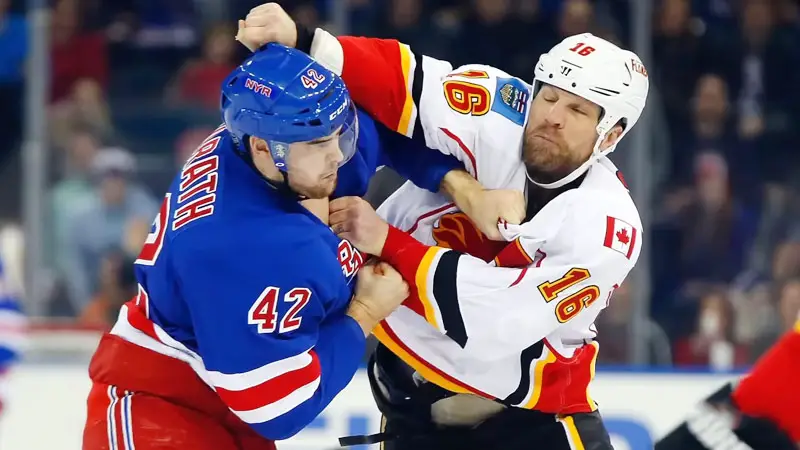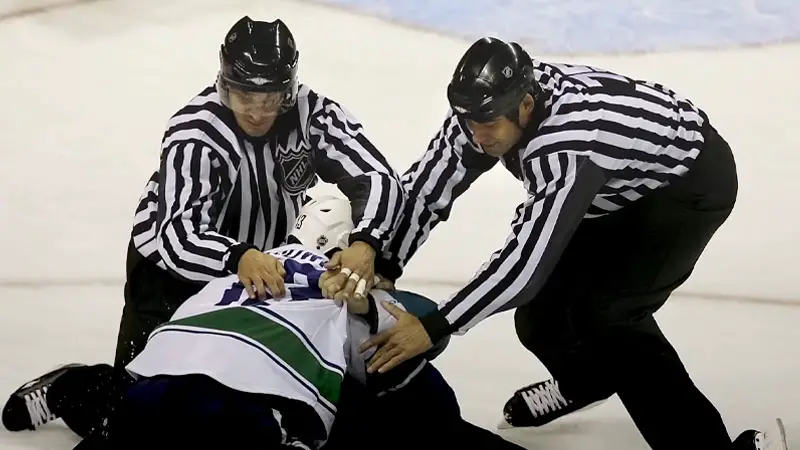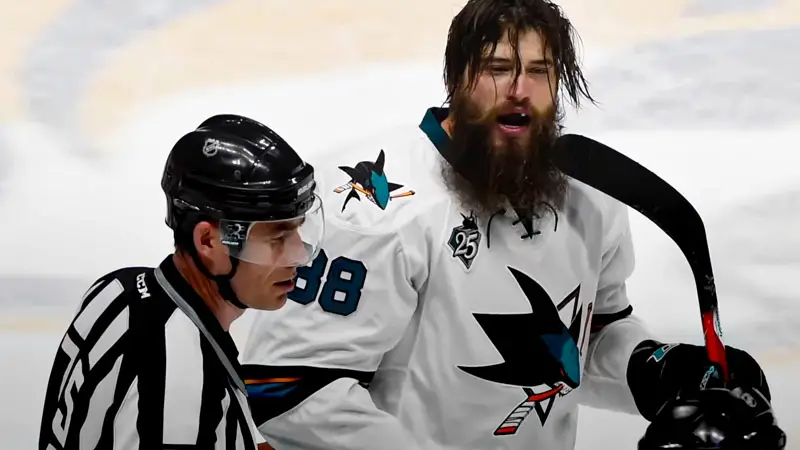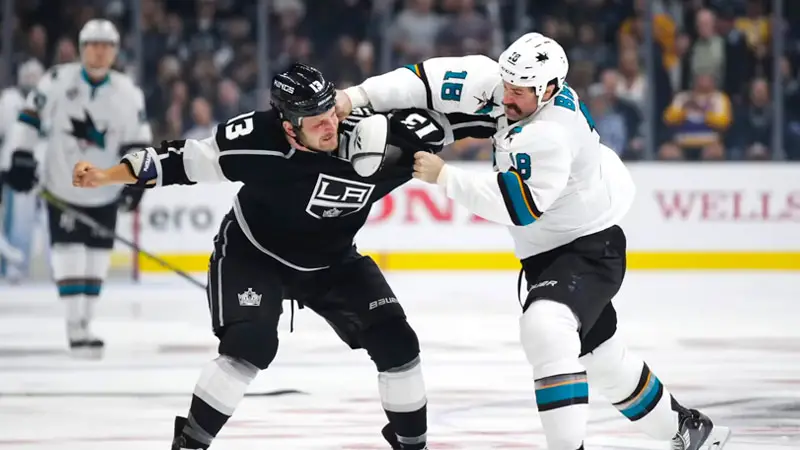Hockey, a sport celebrated for its intensity and physicality, often finds itself under scrutiny for the presence of fights on the ice.
While referees are tasked with maintaining order, there’s a nuanced approach to allowing players to engage in fisticuffs.
This blog post delves into the dynamics of why refs, seemingly paradoxically, permit hockey players to fight. From historical roots to the concept of player accountability, we’ll explore the reasons behind this aspect of hockey culture.
However, it’s essential to recognize the evolving landscape of the sport, with an increasing emphasis on player safety, rule enforcement, and the consequences players face for engaging in fights.
Fight in A Hockey Match
While physical contact is inherent to hockey, it’s crucial to emphasize that fighting is generally not condoned within the rules of the game.
In most organized hockey leagues, players engaging in fights receive penalties and often face subsequent disciplinary actions.
Here’s how fighting is typically addressed in hockey:
- Penalties: When players engage in a fight, they receive penalties. These penalties can result in the players spending time in the penalty box, leading to their team playing shorthanded.
- Ejections: In some cases, fights may lead to ejections from the game, particularly if they are deemed particularly severe or if the players refuse to stop after being instructed by the officials.
- Suspensions and Fines: In addition to in-game penalties, players involved in fights may face additional consequences, such as suspensions and fines imposed by the league.
- Deterrence: Leagues discourage fighting to promote a safer and more sportsmanlike environment. The penalties associated with fighting serve as a deterrent to players, aiming to minimize unnecessary violence on the ice.
While fighting has been a part of hockey culture, there has been a growing effort to reduce and eliminate it from the game.
Many hockey leagues are prioritizing player safety and emphasizing skill and sportsmanship over physical altercations.
It’s important for players and fans to understand and respect the rules and regulations set by the governing bodies of the sport.
Why Do Refs Let Hockey Players Fight?

While fighting is not explicitly allowed in hockey, referees often exercise some discretion when it comes to enforcing penalties for fighting.
Fighting is generally penalized in hockey, but there are a few reasons why officials might not immediately intervene:
Player Policing
Some argue that allowing players to police themselves through fights can help maintain order on the ice. If players know there’s a consequence for their actions, they might be less likely to engage in dirty play.
Entertainment Value
Unfortunately, fights have become a part of the spectacle for some fans.
While leagues do not endorse or encourage fighting, some fans find it entertaining, and officials may not intervene immediately to avoid affecting the entertainment value of the game.
Energy and Momentum
Fights can sometimes serve as a way for players to release pent-up energy or frustration. It may also be seen as a way to change the momentum of a game. However, this is a controversial perspective, and not all agree with it.
Unwritten Rules
In the culture of hockey, there are sometimes unwritten rules that players are expected to follow. Occasionally, players may engage in fights as a way to settle disputes or uphold perceived codes of conduct.
It’s important to note that while fights may occur, hockey leagues generally discourage them. Players involved in fights receive penalties, including time in the penalty box, and may face additional disciplinary actions from the league.
In recent years, there has been a trend in professional hockey leagues to crack down on fighting and promote a safer, more skill-focused game.
How Fighting Became an Integral Part of Hockey Culture?

The integration of fighting into hockey culture has historical roots and evolved over time. While it’s not officially part of the game’s rules, fighting has become somewhat ingrained in the sport’s culture for several reasons:
Physical Nature of the Game
Hockey is a physically demanding sport with a lot of contact. The fast-paced nature of the game, combined with players competing for space and possession of the puck, can lead to heightened emotions and occasional conflicts.
Unwritten Codes
Over the years, hockey has developed unwritten codes of conduct among players. Some believe that fights can serve as a form of self-policing, allowing players to address perceived injustices or enforce a sense of order on the ice.
Entertainment Value
While leagues do not endorse fighting, some fans have come to expect and enjoy the physicality of the sport, including fights. This perception has led to a cultural acceptance of fighting in certain hockey circles.
Changing Momentum
In some cases, fights are seen as a way to change the momentum of a game. Teams might engage in fights strategically to energize their players or intimidate the opposition.
Tradition
Hockey has a long history, and certain aspects of the game, including fighting, have been passed down through generations. The acceptance of fighting in the past has contributed to its continued presence in the culture of the sport.
It’s important to note that despite these historical reasons, the perception of fighting in hockey has been changing. Many leagues are now actively working to minimize fighting and promote a safer, more skill-focused game.
Role of Fighting in Enforcing Player Accountability in Hockey

One perspective on the role of fighting in hockey, especially in the past, is that it served as a means of player accountability and self-policing. Here are some arguments made in favor of this viewpoint:
Deterrence
Supporters of fighting argue that the potential for physical altercations serves as a deterrent, discouraging players from engaging in overly aggressive or dangerous plays.
The fear of facing the consequences in the form of a fight on the ice could prevent some players from taking liberties that might lead to injuries.
Enforcing Unwritten Codes
Hockey has a unique culture with unwritten codes of conduct among players. Some believe that fighting allows players to address perceived injustices or breaches of these codes.
This form of self-regulation may help maintain a sense of order and respect among players.
Team Unity
Engaging in a fight, particularly in defense of a teammate, can foster a sense of unity within a team. It sends a message that players are willing to stand up for each other, reinforcing bonds and camaraderie.
Momentum Shift
Fighting can be seen as a way to change the momentum of a game. If a team is struggling or needs an emotional boost, a well-timed fight might energize the players and the fans, potentially turning the tide in favor of the team.
Despite these arguments, it’s important to note that the role of fighting in hockey has been a topic of ongoing debate.
In recent years, there has been a shift in the mindset of many hockey leagues towards prioritizing player safety, skill development, and sportsmanship.
Leagues are implementing stricter rules and penalties for fighting, reflecting a broader trend toward minimizing violence and promoting a more controlled and respectful style of play.
When Referees Step in to Break up Fights in Hockey?
In hockey, referees are responsible for maintaining order on the ice and enforcing the rules of the game. When fights break out, referees have specific guidelines for when and how to intervene.
Here are common scenarios when referees step in to break up fights:
Safety Concerns
Referees prioritize player safety, and if a fight becomes particularly dangerous or players are at risk of serious injury, referees will step in immediately to stop the altercation.
Extended Duration
If a fight goes on for an extended period, referees may choose to intervene to prevent further escalation and restore order to the game.
Both Players Engage
If both players willingly and actively participate in the fight, referees are more likely to let the altercation play out to a certain extent. However, if it continues for too long or becomes particularly intense, they will step in.
Refusal to Stop
Referees will issue verbal warnings to players to stop fighting. If the players continue despite the warning, referees will intervene physically to separate them and bring an end to the fight.
Rule Violations
Referees will step in if the fight involves rule violations beyond the standard fisticuffs. For example, if a player removes their helmet before or during a fight, the officials may intervene due to safety concerns.
It’s important to note that fighting is penalized in hockey, and players engaging in fights receive penalties, including time in the penalty box. Additionally, leagues may impose fines and suspensions for players involved in fights.
FAQs
Why do referees allow fights in hockey?
Referees don’t actively permit fights, but they exercise some discretion. Fights have historical roots in hockey culture, seen by some as a form of player accountability.
However, leagues penalize fighting, and officials intervene when safety is at risk or if the altercation persists beyond acceptable limits.
Is fighting part of the official rules in hockey?
No, fighting is not part of the official rules in hockey. The sport’s regulations discourage and penalize fighting.
Players engaging in fights receive penalties, time in the penalty box, and may face additional disciplinary actions from the league.
Do referees intervene immediately when a fight breaks out?
Referees generally issue warnings and allow players to stop voluntarily.
However, if a fight poses a safety risk, persists too long, or involves rule violations, referees will intervene promptly to separate the players and restore order to the game.
Are there any benefits to allowing fights in hockey?
While some argue that fights deter dangerous plays and foster team unity, the sport is moving away from this perspective.
Leagues increasingly prioritize player safety, skill development, and sportsmanship, discouraging fighting. The potential risks and negative impact on the game’s image outweigh the perceived benefits.
Are there consequences for players involved in fights?
Yes, players engaging in fights receive penalties, leading to their team playing shorthanded. Beyond in-game penalties, players may face fines and suspensions imposed by the league.
The push for a safer and more skill-focused game means that fighting is generally discouraged and carries significant consequences.
Wrapping Up
In the world of hockey, the allowance of player fights is a complex interplay of tradition, unwritten codes, and evolving perspectives.
While fights were once somewhat accepted as a form of self-policing and team unity, the modern hockey landscape is shifting.
Leagues now prioritize safety, sportsmanship, and skill development, leading to increased penalties and consequences for fighting. Referees walk a fine line, weighing the historical context against the growing demand for a cleaner, safer game.
As hockey continues to evolve, the role of fights may further diminish, making way for a sport that emphasizes skill, strategy, and a commitment to the well-being of its players.








James Felix